The blog/website of Dr Fabrice Cognot, PhD, Bladesmith. All content here is property of Fabrice Cognot, unless stated otherwise. Asking for permission is the mark of a civilised mind - although, reversely, if ever anything should not be here, just let me know and I'll act accordingly. #Fab_Bladesmith on Twitter, @fabbladesmith on instagram, fab.cognot as an email on gmail.com. Feel free to get in touch !
Don't wanna be here? Send us removal request.
Text




A Blue Longsword (The Dream part 1)
Part of a full set I'm making for me mate Paul (as the great Philomena Cunk would say).
Spring steel blade, mild steel fittings, heat-blued. Grip is leather over cord over wood.
1188 mm long, blade is 6 mm thick at its base, 922 mm long, cross span is 226 mm.
Weight is 1394 g, with the point of balance 105 mm down the blade.
50 notes
·
View notes
Text




A Long Knife, in a late XVth century fashion.
Spring steel blade with a short edge, and old wrought iron fittings showing a lovely texture - the flow and curves of which following the forge work that created them.
And curly maple scales with hand-rolled brass pins.
The cross is secured with the usual Nagel, but also by hammering the blade shoulders that slightly protrude from the grip side of the guard (which is actually a glorified bolster of sorts).
It might be given a scabbard at some point.
Length is 822 mm with a 630 mm blade, 38 mm wide and 6.2 mm thick at its base, properly tapering. Cross has a span of 163 mm.
63 notes
·
View notes
Text



A PhD Sword.
Commission work.
In a few civilised countries out there, custom is to present new Doctors with a sword for their graduation - a thing I can but fully agree with.
This one however is flying to other skies.
Spring steel blade, and sand-cast bronze fittings, then gold-plated. The grip is water buffalo horn with gold-plated copper wire.
Scabbard is leather over linen wrap over wood, and the throat and chape are a gold-plated mix of brass and steel.
You'll notice a recurring theme on that one.
60 notes
·
View notes
Text

As of today, this gallery is 11 years and 1 day old ! Thank you all for your support, your trust and your appreciation ! Cheers Fab
13 notes
·
View notes
Text







A Partisan. Italy, early XVIth century. (commission work - not for sale)
Heavily inspired by object 08.261.2 from the @metarmsandarmor
Spring steel blade and lugs, and welded-on mild steel socket. A strong spine runs from the base of the blade to the point, and the lugs are thicker at their end, as per many examples of other polearms from the XVth century onwards. The section between each pair of lugs is fileworked.
The blade and lugs sport foliate scrollwork, with the prominent face of the Wild Man, so popular back then, right in the middle, in lines of punched dots - I honestly haven't counted how many - and gold-plated. It was a bit of a guesswork to reconstruct the design from the originsl example, very worn as it is. I hope I'm not too far off. Seeing a similar technique used on corseque VII.1340 from the @royalarmouriesmuseum prompted me to go for gold on this one. The socket was left heat-blued/blacked, for the contrast it offers with the gilded parts.
The haft is ash, with a decahedric cross-section and a reinforced butt.
Please disregard the lack of pins and nails, as they will be added by the final owner - this one will have to be shipped unmounted.
Overall length 2497 mm, with 760 mm from the point to the opening of the socket. Main lugs span is 178 mm, secondary lugs span 114 mm. Weight is 1960 grams.
84 notes
·
View notes
Text



A Purpleheart Friction Folder
Tool steel blade with a subtle selective hardening, though barely visible on the pics, and light filework. Purpleheart handle with fileworked mild steel spacer.
204 mm open, 119 mm closed.
Now at two hundred and sixty European units.
28 notes
·
View notes
Text


High carbon steel blade with differential hardening and light filework, and heat-blued handle.
90 mm closed, 142 mm when open. 275 € plus shipping
31 notes
·
View notes
Text






A Schlachtschwert, late XVIth/early XVIIth century.
Spring steel blade, oil-blacked cross and pommel made of mild steel, and vegetable tanned leather over wood for both grip and the sleeve thing that comes over the ricasso. All hand-forged, filed, carved and decorated.
165.2 cm long and about 10 mm thick at its base, tapering to about 2 mm near the point ; cross span is 39 cm, weight is 2951 grams, and point of balance is right at the lugs, as should be.
Exploring yet another variant of cross and pommel style here.
Contrarily to the popular belief, and even though they ended up in such a role in later times, these were not just processional swords, but powerful weapons of war. Now at five thousand euros, shipping not included.
128 notes
·
View notes
Text






Claidheamh dà làimh dhubh
A Black Claymore, in the West Highland style, second half of the XVIth century.
Inspired by a variety of surviving examples, this one shows the classic features of the type, with quadrifoils at the end of the downturned quillions of strong rhombic section, fileworked central langets, hollow pommel and top finial. The swelling on the grip is inspired by the sword kept at the Kelvingrove Museum in Glasgow and is leather over wood - most grips visible in such swords nowadays are modern replacements.
Fittings are mild steel, oil-blacked.
The engraved blade is spring steel, made after the various examples of German productions.
See Tony Willis, "the Scottish Two-Handed Sword", Bulletin of the American Society of Arms Collectors 120, pp. 35-69.
Overall length is 1405 mm, blade is 1020 mm long and 45 mm wide, and shy of 5.4 mm thick at its base.
Cross span is 145 mm.
Weight is 1809 grams, point of balance 17 cm from the cross.
Again, sharing from here will only share this picture, so if you want to share the intire set of photos, do it from my Dr Fabrice Cognot, Phd, Bladesmith Page
Thanks
142 notes
·
View notes
Text



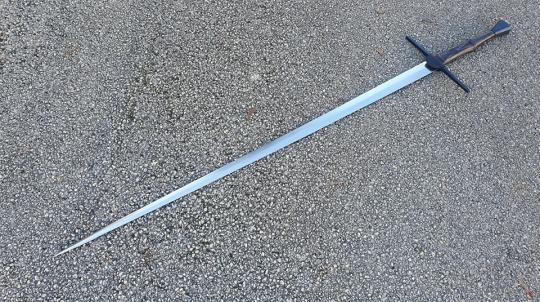
A Light Longsword, late XVth century
Inspired by various examples - especially those swords I saw during my latest visit at the @museearmee_invalides - and by the numerous effigies of the late 1400s from the Holy Roman Empire, more specifically this very specific type of grip with saltire-shaped risers and a leather flap over the middle of the cross.
Spring steel blade, heat-greyed fittings, grip is leather over wood with linen thread risers.
It is on the smaller end for such swords, but still rather powerful.
1140 mm long, blade is 906 mm, cross is 213 mm, and weight is a mere 927 grams still with a lot of punch. Point of balance is 12 cm from the cross.
Blade starts short of 6 mm thick, tapers gradually and then thickens a bit at the reinforced point, as should be.
I'm offering it for two thousand units of European money, adding six hundred for a scabbard.
72 notes
·
View notes
Text



Those of you who know will recognise what it is inspired by
Hint: it is *not" a reproduction/recreation of an historical piece, though it shares some details with them.
The hardest part for me was to give it this video game look, which isn't really similar to the real stuff...but hey, it was fun.
Spring steel blade, brass-plated fittings, leather over wood for the grip, held in place with cheese glue.
Carving on the pommel, etching in the fuller.
Didn't take measurements, but weight is about 1540 grams
161 notes
·
View notes
Text






A Celtic Anthropomorphic Hilted Short Sword/Dagger and Scabbard, 1st cent. B.C.
Based mostly on two local examples (one found in 1900 in Mirebeau-sur-Bèze, and the other in the river Saône, at the ford called "Iles Percées" in 1974, and both kept in the @museedenon in Chalon-sur-Saône) as well as others.
The blade is high carbon steel with a hollow ground diamond section, and has been slack-quenched so that only the edges would harden. A sun, crescent moon and two silver lines were inlaid on one face.
The hilt is bronze, cast in 4 parts. The shape of it recall the "proper" anthropomorphic hilts of the earlier phases in a simplified form, but it's not hard to identify the legs, body, arms and head. The scabbard is bronze, and as should be can be taken down relatively easily. The front plate overlaps the back plate on the sides, and the throat piece and chape also keep holding these two together.
I have a boundless admiration for the Celtic smiths of old.
There is both much to say about these swords - questions, mostly, and not much in terms of answers.
Such swords appear all over Europe, and a striking feature in addition to the hilt is these inlays of a moon and a sun - though some swords only show a single central strip of gold. Maybe my current reads on metal finishes has me overthink on the meaning of these inlays - or rather, the fact that they did have a meaning, now lost to us.
But it made sense to me that the blade could have been heat-blued, to emphasise the moon and sun at twilight - the silver lines could then be the Milky Way or the Divide between Night and Day, maybe at the time of the Equinox.
Bluing of blades is also found later on inlaid Mediaeval swords, with a possibility of a continuity of this technique. I'd say more, but space here is limited. I don't know.
Not to mention the strong symbolism of the scabbard (you do know the Latin word for scabbard, right ?) associated with the blade dangling between the hilt's "legs". Ritual blade fitting with fertility/astronomy/renewal of the cycle ?
Damn you, Celts and Gauls, who made such marvels and didn't write down a thing, and now all is lost in the sea of Time and Silence.
All that we can affirm is the undeniable highly symbolic meaning of such artifacts - as the Archaeologist in me would say.
Many thanks to Dr Guillaume Reich - leading expert on La Tène weapons - for the advice, insight and bibliography.
164 notes
·
View notes
Text

An attempt at a decent pic of the hilt of this sword - a tricky thing, with all the reflections.
The process for making such decoration is basically to cut grooves/channels in the surface of the hilt elements, either with a square chisel or a metal saw, and then to hammer in small cuts of well annealed metal wire (here silver and brass). Said wire needs to fill in the channel - hammering them in secures a tight fit - but also to "overflow" a bit ; they will hopefully spread under the hammer blows and cover the top of the walls separating each groove. No need to undercut.
For each square of this checkered pattern, an average of 4 cuts of wire were used. Needless to say, it is a lengthy process but I'm very much looking forward to doing it again.
The silver decorative elements between the pommel lobes and the pommel and rear guard are silver. I took a 3 mm wire and rolled it between a hardened wedge of steel and a flat, hard surface. Again, the wire needs to be well annealed beforehand, and also required annealing afterwards as the process of rolling significantly work-hardened it.
39 notes
·
View notes
Text







A Carolingian Sword and Scabbard, 9th century.
The blade has a 3-layer core of mild steel over high carbon steel, and high carbon steel edges.
Hot-welded in the fullers are the famous "+ULFBERH+T" mark on one side, and "III XX III" on the other, in pattern-welded 1075 and 15N20 steel - this latter thing being, in my educated opinion, no less important than the other side. Many things have been said about such marks, but the most important thing about them is that they exist (otherwise, to paraphrase Sir Terry Pratchett, it wouldn't be a real sword, just a very dangerous bit of sharp metal) and that they are but one aspect of the continuous function of the sword to carry a message/prayer/ritual thing, a thing appearing as early as the Bronze Age and which would continue up to the Renaissance if not after - working in conjunction with the scabbard to utter/read these spells when the sword is drawn or put back in the scabbard.
The hilt is inspired by sword FG2187 of the Germanisches National museum, found near Mannheim, and is mild steel overlaid in brass and silver (thanks to Matt Bunker for the close-ups), with silver details.
For the grip I drew inspiration from a sword found in river Shannon in 2012 for the placement of the linen threads under the leather cover, which provide both a decorative function and a nice feeling in hand. The overall shape of the grip was determined by stylistic elements of various swords of other types.
The scabbard is leather over linen over steam-formed wood, and lined with 100% wool cloth, stitched at the throat with pure silk thread. I chose not to give it a chape, the end being reinforced by a thick wrap of folded linen bands, as according to Dr Geibig's works. Decoration was made using thread glued under the leather cover.
Cheese glue was used for all this.
The suspension system of leather and brass is loosely made after the finds from the Isle of Man (Cronk Moar and Balleteare). The main issue I had was the bottom D-ring/strap thing, and here I propose a simple arrangement of a leather strap riveted to the buckle plate, and made to fit tightly the scabbard when wet. Upon drying, the strap would shrink and securely fit between the two risers.
The strap ends are in the Trewhiddle style, and were made using the historical process of drawing out a billet and chiselling in the decoration, accordingly to the PhD by Gabor Thomas. No casting involved there.
The making of this project owes a lot to the labours of Dr Mikko Molainen, to whom I address all my thanks.
This whole thing needed an awful amount of trial and error, and I am well aware that not everything is perfect there. Apart from the issues mentioned above, the main difficulties were the hot-inlaying/welding of the marks, but I do thing that most of them came from using modern steel - old/bloomery iron, especially with the proper content in phosphorous (wink at @gaelfabre) would have made the welding easier I think. I'll have to give it a try some day.
152 notes
·
View notes
Text
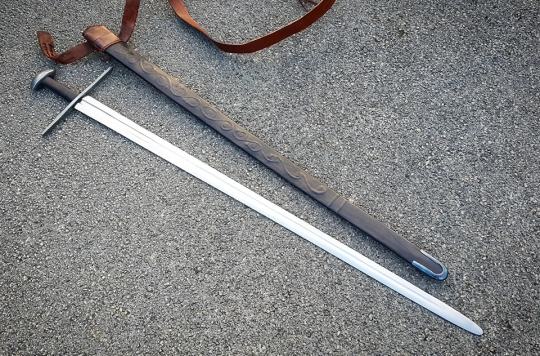
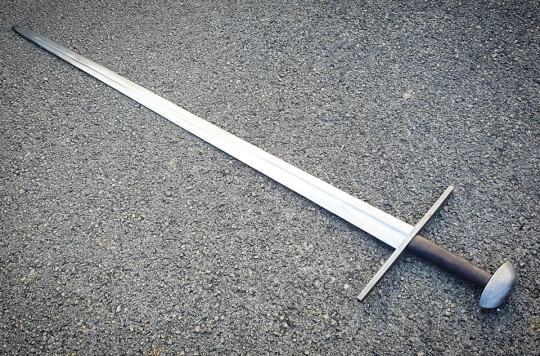

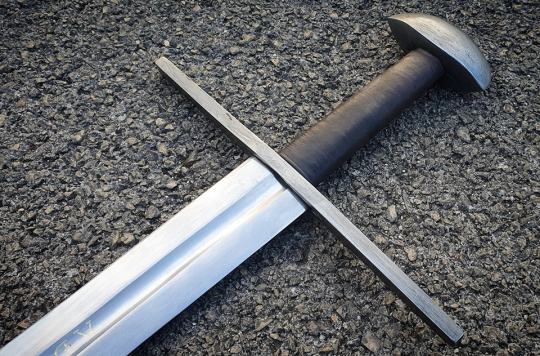

A Sword and Scabbard, in the style of the XI-XIIth centuries.
The blade itself follows one of the possible construction methods of the time, albeit being made of modern materials: a layer of high carbon steel forge-welded between lower carbon alloy. Thus hard steel is kept for the edges, and softer metal for the rest - which was also the point, as the fuller sports on both sides an inlay is brass, and although what it spells is not really historically accurate, the lettering at least is.
The straight Cross and Brazil Nut Pommel are of old iron with a nice, rich pattern, and both were made the "old way", with hammer and fire, according to methods I documented over the course of my PhD.
The Grip is vegetable tanned leather over linen thread over wood.
The scabbard is lined with parchment, and is made of beech wood covered in linen cloth - wrapped over near the point - and vegetable tanned leather. The decoration was made by gluing flax thread and leather cuts over the linen, and is inspired by folio 89 of the ms.002 (tome II) in the City Library of Boulogne-sur-mer.
The suspension system was heavily inspired by the wonderful scabbard in the treasury of the Bamberg cathedral (thanks to Roland Warzecha a.k.a. Dimicator for sharing this with us all), though here I used calf leather.
Chape is hand-forged in steel, and heat-blued.
It is 1018 mm long, with a 888 mm blade, 40 mm wide and 4.65 mm thick at its base. The span of the cross is 205 mm.
And although quite light (771 grams) it is still a powerful cutter, with a center of gravity some 18 cm down the blade.
Making this set was quite the learning experience, as it often is, and that's also one of the highlights of this trade.
Thanks to all who made this possible.
154 notes
·
View notes
Text
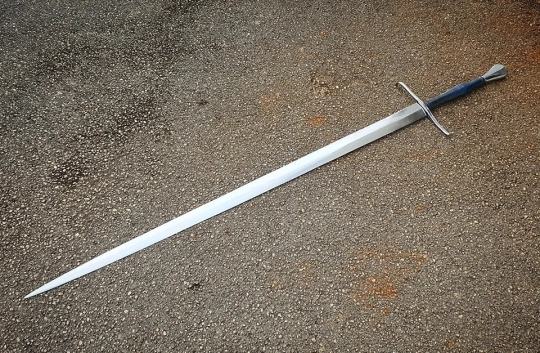

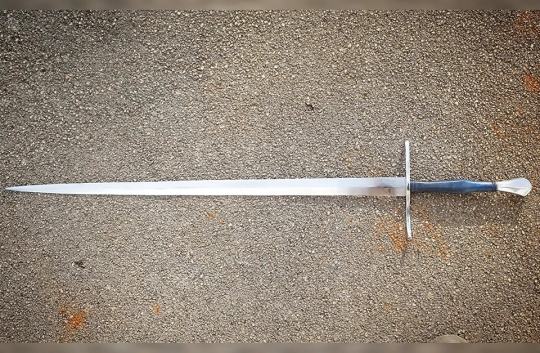


A Longsword, in a late XVth century German fashion.
Not a copy of a specific sword, but something that goes along with the style of such swords. Spring steel blade, mild steel cross and pommel, and leather over linen cord over wood grip. All hand-made, naturally.
Overall length 1209 mm, with a 945 mm blade (43 mm wide/6.14 mm thick at its base). Crossguard span is shy of 22 cm.
Weight is 1163 grams, with a point of balance 15 cm down the blade from the cross, giving this rather light sword some nice authority in the cut and the bind.
As always, more pics in the comments.
Yours for two thousand units of the Old World currency.
Can be given as scabbard for a few credits more.
237 notes
·
View notes
Text



A Schlachtschwert, early XVIth century.
Spring steel blade of flat hexagonal section for most its length, mild steel fittings with hollow brass ball finials on the cross. Leather over thread over wooden core for the grip, and leather over wood for the sleeve (more about that below). This is a tentative reconstruction of what a "proper" Landsknecht Greatsword could look like, such a they appear on period artwork, be it paintings like the Siege of Alesia by Melchior Feselen (1533) or the Battle of Pavia kept at the Royal Armouries (or the tapestries depicting that same battle, now at the Museo Capodimonte, made after sketches by Bernard van Orley), the Victory of Charlemagne over the Avars near Regensburg by Albrecht Altdorfer (1518), or the many drawings, prints and woodcuts by artists such as Reinhart von Solms, Jörg Breu, the great Hans Burgkmair, Niklas Stör, Hans Holbein (both Elder and Younger), Virgil Solis, Hans Sebald Beham, the legendary Urs Graf, Daniel Hopfer, Erhard Schön, Hans Schäufelein and others...All of them combined to give this result.
Such swords would be seen not only in the hands of a Doppelsoldner, but also carried by your Feldwaybel or an Edelman. And it would be called a Schlachtschwert in the very captions of the illustrations I mentioned earlier (see Erhard Schön). *Not* a "two-handed Katzbalger", though the cross obviously echoes the S/8-shaped guard of the latter. We clear on that ? Good.
Very few of such swords are kept in museums out there, with a lot of them leaving me dubious regarding their authenticity. The one in Berlin seems to me to be the most genuine of all, and it is on its proportions that I based this piece, though the Berlin sword shows a fancy, diamond-pattern decoration on the quillions very much recalling the Katzbalger kept in the Museum of London. Most if not all period illustration do not show such fancy details on the crossguards though ; they are actually rather plain, without even the ribbing/threading/filework you can find on Katzbalger crosses. Hence I kept this one rather plain, with a square cross section with rounded corners, and some light filework at the center. I also bent the quillions into an offset 8-shape rather than a symmetrical one, to be more consistant with the earlier examples visible in period artwork.
The main questioning was that sleeve at the base of the blade, present on a lot of the period artwork; its obvious function was to provide a spot on which to put the other hand - as can be deduced from Marozzo's teachings for fighting against polearms - but the main issue was how was it made/what was it made of. Elaborating on my previous experience and studies of such things on later Schlachtschwerter, I went for a basic construction of leather glued/stitched over a wood core made of two flat slabs, and force-slid down the blade. There is more than enough friction to keep it well in place, but it is still possible to take it off albeit with some effort. The end of the leather is cut according to period artwork, and flares out to accommodate the mouth of a scabbard if needed. A simple decoration of plain lines on one side, and checkered on the other makes it also consistant with the artwork.
It is 139 cm long, the blade is 1083 mm long, 45 mm wide with a thickness of about 7 mm at its base, tapering down to 3.4 mm near the point. The span of the crossguard is about 21 cm, though from one ball end to the other there's about 73 cm of steel. Weight is 2547 grams, point of balance 13.5 cm from the cross.
Twenty-eight hundred EuroUnits and it's yours.
189 notes
·
View notes